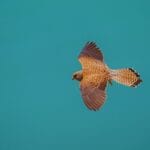During the second weekend of January (10-12th of January), like every year, the Albanian Ornithological Society (AOS) became part of the “International Waterbirds Census” (IWC) 2020. This international monitoring program is implemented in more than 143 countries and has been implemented in Albania since 1993. It has become a tradition for IWC to be joined by interested persons, volunteers, experts, local people, and every year their presence is increasing. Albanian Ornithological Society is responsible for the coordination of IWC at the national level, and during IWC 2020 in Albania, AOS played a pivotal role in standardizing counts and coordinating the whole process.
More than 120 participants were involved in counting, monitoring and assessing. The entire process and each team were led and supervised by seven experts of AOS, PPNEA, RAPA Kukës, Tirana University, Agricultural University of Tirana. These were supported by the National Agency of Protected Areas and the 12 Regional Agencies of Protected Areas which provided both human and logistic capacities.
Sites covered by IWC 2020 in Albania

Unlike the previous year, where IWC 2019 team observed 25 wetlands, IWC 2020 team visited 29 different wetlands sites. Four wetland sites became part of IWC Albania wetlands list, namely Kashari lake, Paskuqani lake, Tapiza lake, and Bovila lake.
What do the results of IWC 2020 show?

151 thousand waterbirds and 65 waterbird species were registered in the visited wetland sites. The number of waterbirds in 2020 is higher than in 2018 and 2019. But it is lower than in 2017 when circa 165 thousand birds were reported. The above shows that during the last years (2013-2020) the overall figure of waterbirds is showing fluctuations but not a clear increasing or decreasing trend. Meanwhile, the long-term trend, starting in 1996, shows that the number of waterbirds is decreasing.
Which wetland site has the highest number of waterbirds observed?
Divjaka-Karavasta, with circa 42 thousand waterbirds and 55 waterbird species was confirmed this year as the most important wetland site for waterbirds. The second most important wetland based on the number of waterbirds is Shkodra lake with circa 41 thousand specimens and 22 waterbird species. Those two sites are followed by Vjosë-Narta, Macro Prespa, and Ohrid. Divjaka-Karavasta records again the highest number of waterbird species. Other important sites are Vjose-Narta, Butrinti, Kune-Vaini, and Orikumi.
Which are the most common species observed during the IWC 2020 in Albania?
[/et_pb_text][/et_pb_column][/et_pb_row][et_pb_row column_structure=”1_5,1_5,1_5,1_5,1_5″ _builder_version=”3.26.3″][et_pb_column type=”1_5″ _builder_version=”3.26.3″][et_pb_circle_counter title=”Coot (Fulica atra) ” number=”38″ bar_bg_color=”#0c71c3″ circle_color=”#000000″ circle_color_alpha=”0.25″ _builder_version=”3.26.3″ title_level=”h5″ title_text_align=”center” title_font_size=”14px” title_line_height=”1.2em”][/et_pb_circle_counter][/et_pb_column][et_pb_column type=”1_5″ _builder_version=”3.26.3″][et_pb_circle_counter title=”Balck-headed Gull (Croicoephalus ridibundus)” number=”11%” bar_bg_color=”#0c71c3″ circle_color_alpha=”0.25″ _builder_version=”3.26.3″ title_level=”h5″ title_text_align=”center” title_font_size=”14px” title_line_height=”1.2em”][/et_pb_circle_counter][/et_pb_column][et_pb_column type=”1_5″ _builder_version=”3.26.3″][et_pb_circle_counter title=”Eurasian Wigeon (Mareca penelope)” number=”9%” bar_bg_color=”#0c71c3″ circle_color_alpha=”0.25″ _builder_version=”3.26.3″ title_level=”h5″ title_text_align=”center” title_font_size=”14px” title_line_height=”1.2em”][/et_pb_circle_counter][/et_pb_column][et_pb_column type=”1_5″ _builder_version=”3.26.3″][et_pb_circle_counter title=”Eurasian Teal (Anas crecca) ” number=”7%” bar_bg_color=”#0c71c3″ circle_color_alpha=”0.25″ _builder_version=”3.26.3″ title_level=”h5″ title_text_align=”center” title_font_size=”14px” title_line_height=”1.2em”][/et_pb_circle_counter][/et_pb_column][et_pb_column type=”1_5″ _builder_version=”3.26.3″][et_pb_circle_counter title=”Dunlin (Calidris alpina) ” number=”3%” bar_bg_color=”#0c71c3″ circle_color_alpha=”0.25″ _builder_version=”3.26.3″ title_level=”h5″ title_text_align=”center” title_font_size=”14px” title_line_height=”1.2em”][/et_pb_circle_counter][/et_pb_column][/et_pb_row][et_pb_row admin_label=”row” _builder_version=”3.25″ background_size=”initial” background_position=”top_left” background_repeat=”repeat”][et_pb_column type=”4_4″ _builder_version=”3.25″ custom_padding=”|||” custom_padding__hover=”|||”][et_pb_text admin_label=”Text” _builder_version=”3.26.3″ background_size=”initial” background_position=”top_left” background_repeat=”repeat”]
As in previous years, the most common species is the Coot (Fulica atra) with 38% of the number of waterbirds, Black-headed Gull (Croicoephalus ridibundus) with circa 11%, Eurasian Wigeon (Mareca penelope) with 9%, Eurasian Teal (Anas crecca) with 7%, Dunlin (Calidris alpina) with 3%. The International Waterbird Census proved once more the importance of the Albanian wetlands and particularly the importance of coastal wetlands as very distinct wintering and migrating sites for hundreds of thousands of waterbirds, again illustrating the need for conservation of these habitats from loss and degradation.
Meanwhile, IWC 2020 in Albania had a considerable impact beyond the importance of its technical role- wide participation and media coverage helped to bring the spotlight to the importance of Albanian wetlands and its conservation status. Here – you can find one of the broadcasts that has been transmitted in local media.
After all, IWC 2020 in Albania would not have been possible without the commitment and the engagement of experts, Regional Administration of Protected Areas, local supporters, volunteers and AOS team – who were involved in counting, monitoring and assessing for three consecutive days in the field, even in uncomfortable weather conditions. Hopefully, the results of IWC 2021 will surpass those of IWC 2020!
The International Waterbirds Census 2020 in Albania supported by CEPF (Critical Ecosystem Partnership Fund) within the framework of ‘Let’s make Divjaka Natural Again’ project in collaboration with PSEDA-Iliria and ResPublica.





